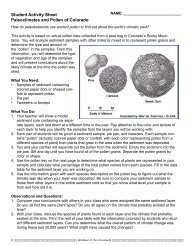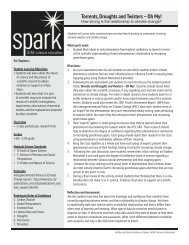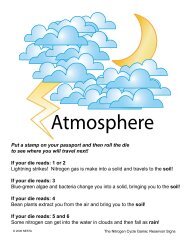Earth's Global Electric Circuit - Spark - University Corporation for ...
Earth's Global Electric Circuit - Spark - University Corporation for ...
Earth's Global Electric Circuit - Spark - University Corporation for ...
You also want an ePaper? Increase the reach of your titles
YUMPU automatically turns print PDFs into web optimized ePapers that Google loves.
Earth’s<br />
Clouds<br />
Earth’s Clouds – Although cloud <strong>for</strong>mation sounds matter-of-fact, many<br />
of the processes that lead to their <strong>for</strong>mation and their role in Earth’s electric<br />
pathways remain mysteries. Scientists interested in modeling Earth’s <strong>Global</strong><br />
<strong>Electric</strong> <strong>Circuit</strong> must gather and analyze cloud data so that these mysteries are<br />
better understood.<br />
Few things are more common in nature than clouds. They are made of water<br />
droplets or ice crystals that are so small and light that they stay afloat in the<br />
air. But how does the water and ice that make up clouds appear? Why do<br />
different types of clouds <strong>for</strong>m? Are small particles needed <strong>for</strong> their<br />
<strong>for</strong>mation? What accounts <strong>for</strong> cloud electrification that can produce lightning<br />
or no lightning at all? And how important are clouds’ contributions and role in<br />
Earth’s <strong>Global</strong> <strong>Electric</strong> <strong>Circuit</strong>?<br />
The water or ice that makes up clouds travels into the sky as water vapor,<br />
the gas <strong>for</strong>m of water, mainly by evaporation from oceans, lakes, and rivers on<br />
Earth’s surface. When air rises in the atmosphere in areas of low pressure and/<br />
or weather fronts, air eventually will cool. When it does, it’s not able to hold all<br />
of the water vapor it once held. Air also cannot hold as much water when air<br />
pressure drops. Consequently, the vapor condenses and becomes small water<br />
droplets or ice crystals, and a cloud is <strong>for</strong>med.<br />
It’s easier <strong>for</strong> water vapor to condense into water droplets when it has a<br />
particle to condense upon. These particles, such as dust and pollen, are called<br />
condensation nuclei. Eventually, enough water vapor condenses upon pieces<br />
of dust, pollen, or other condensation nuclei to <strong>for</strong>m a cloud. Scientists<br />
involved in modeling the <strong>Global</strong> <strong>Electric</strong> <strong>Circuit</strong> are interested in the role<br />
these particles play in impacting the electrical conductivity of the atmosphere<br />
as well as in cloud <strong>for</strong>mation.<br />
Earth’s Lightning and Electrified Storms – Right now, at this<br />
very moment, there are about two-thousand thunderstorms occurring around<br />
the world. Even though thunderstorms are common, they are still dramatic<br />
events with intense rain, hail, wind, lightning, thunder, and even tornadoes.<br />
Many people consider lightning to be the most spectacular element of a<br />
thunderstorm. In fact it is how thunderstorms got their name. Afterall, lightning<br />
causes thunder.<br />
Lightning is a discharge of electricity. A single stroke of lightning can heat the<br />
air around it to 30,000°C (54,000°F)!. This extreme heating causes the air to<br />
expand explosively fast. The expansion creates a shock wave that turns into a<br />
booming sound wave, known as thunder.<br />
As ice crystals high within a thunderstorm cloud flow up and down in the<br />
turbulent air, they crash into each other. Small negatively charged particles<br />
called electrons are knocked off atoms within water molecules as they crash<br />
past each other. This separates the positive (+) and negative (-) charges within<br />
the cloud. Most often, the top of the cloud becomes positively charged while<br />
the base of the cloud becomes negatively charged.<br />
Because opposites attract, the negative charge at the bottom of the storm<br />
cloud wants to link up with the ground’s positive charge or the positive<br />
charges gathered at the cloud’s top. In regard to cloud-too-ground lightning,<br />
once the negative charges at the bottom of the cloud build, a flow of negative<br />
charge called a stepped leader rushes toward the Earth. The positive charges<br />
on the ground are attracted to the stepped leader, so positive charge flows upward<br />
from the ground. When the stepped leader and the positive charge meet,<br />
a strong electric current carries positive charge up into the cloud. This electric<br />
current is known as the return stroke. We see it as the bright flash of a<br />
lightning bolt followed by thunder.<br />
Earth’s<br />
<strong>Electric</strong>al<br />
Storms<br />
Cloud questions are plentiful, especially in terms of their microphysics and<br />
their role in the <strong>Global</strong> <strong>Electric</strong> <strong>Circuit</strong>. How do electro-magnetic fields<br />
develop, and how do they influence clouds to produce powerful lightning or<br />
no lightning at all? What role do thunderstorms and other electrified,<br />
non-lightning or lightning-producing clouds play in maintaining the potential<br />
difference in electricity between Earth’s surface and the upper atmosphere?<br />
What type of electrical currents do these clouds produce, and are the currents<br />
stronger, weaker, or the same over land and ocean?<br />
These are the kinds of questions that scientists need to find answers to in<br />
order to adequately build a model of the system. The physics and microphysics<br />
that occur on very small scales to produce electricity in a cloud are also<br />
critical. Research suggests that precipitation-based charging is the<br />
strongest precursor <strong>for</strong> an electrified thunderstorm. In fact, thunderstorms are<br />
thought to play a major role as generators of Earth’s fair-weather curcuit.<br />
Thunderstorms and lightning represent one of the sources within this global<br />
electrical system. But there are still questions as to how much lightning<br />
charges contribute. It’s also very interesting to know how much Transient<br />
Luminous Events contribute, incluidng sprites, elves, and blue jets. They are<br />
related to lightning and/or thunderstorms so their influence is of equal<br />
importance.<br />
Gigantic Jets are another type Transient Luminous Event. They are especially<br />
interesting because they take the negative charge from thunderclouds and<br />
transport it to the ionosphere. They also <strong>for</strong>m a direct pass of electrical contact<br />
between a thundercloud and the lower ionosphere. Consequently, they are of<br />
great interest from the point of view of the <strong>Global</strong> <strong>Electric</strong> <strong>Circuit</strong>.<br />
14. 15.















